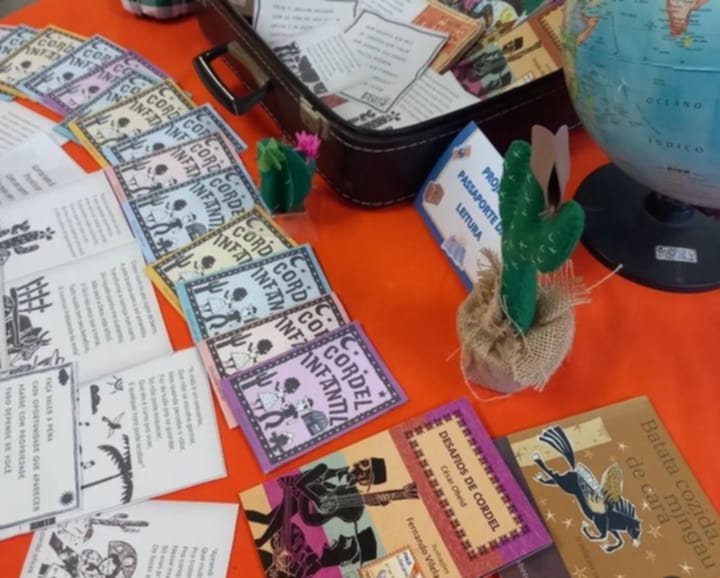
[PT]
A literatura nordestina é conhecida mundialmente, principalmente os cordéis, esse patrimônio imaterial brasileiro surgiu com a influência dos portugueses. O cordel abordou situações, histórias e lendas nordestinas, fortalecendo o folclore e o imaginário das pessoas.
O cordel nordestino surgiu em Portugal com os trovadores medievais, séculos XII e XIII, época onde se destacavam os poemas cantados e o conto de histórias para a população em geral. Chegando ao Brasil, meados do século XVII, começou a ganhar identidade adaptando-se a cultura local e fortalecendo as culturas regionalistas do Norte e Nordeste do país.
A escrita dos cordéis expressa uma ficção regionalista do Nordeste brasileiro, fortalece o imaginário dos leitores e retrata as características presentes na região, destacando traços importantes como a seca, as dificuldades, a persistência, a superação e a evolução dos nordestinos em meio as dificuldades da vida. Essas manifestações culturais são destacadas em meio a diversidade cultural presente brasileira, ressaltadas de forma alegre e atrativa.

Quando os cordéis associaram a oralidade ao material físico, suas criações passaram a ser vendidas em bancas, feiras e mercados. Para ganhar visualização em meio a um movimento literário, as obras foram penduradas em cordões (cordéis). Esse formato literário mantém a maioria de suas características tradicionais até os dias de hoje: oralidade, ilustrações em xilogravuras, temática e poética.
Autores famosos do Nordeste que utilizaram os cordéis em suas obras:
Jorge Amado - Bahia
Tobias Barreto - Sergipe
Nísia Floresta - Rio Grande do Norte
Rachel de Queiroz - Ceará
Augusto dos Anjos - Paraíba
João cabral de Melo neto - Pernambuco
Lêdo Ivo - Alagoas
Ariano Suassuna - Paraíba
Olegário Alfredo - Minas gerais
Ao conhecer a encantadora literatura de cordel, não podemos esquecer de alguns cordéis famosos que fizeram e fazem história até os dias de hoje:
O poeta da roça de Patativa de Assaré;
Ai se sesse de Zé da Luz;
O romance do pavão misterioso de José Camelo de Melo Resende.
É uma cultura atrativa e encantadora que atrai a atenção de todos, um mundo mágico que associa o mundo real a imersão ao mundo dos cordéis.

Todo o conteúdo, imagens e edições foram produzidos por @josiva para a comunidade @HiveBR.
[EN]
Northeastern literature is known worldwide, especially the cordels, this Brazilian intangible heritage emerged under the influence of the Portuguese. The cordel addressed northeastern situations, stories and legends, strengthening people's folklore and imagination.
The northeastern cordel appeared in Portugal with the medieval troubadours, in the 12th and 13th centuries, a time when sung poems and storytelling for the general population stood out. Arriving in Brazil in the middle of the 17th century, it began to gain identity by adapting to the local culture and strengthening the regional cultures of the North and Northeast of the country.
The writing of the cordels expresses the regionalist fiction of the Brazilian Northeast, strengthens the imagination of readers and portrays the characteristics present in the region, highlighting important features such as drought, difficulties, persistence, overcoming and the evolution of Northeasterners amidst the difficulties of life. These cultural manifestations are highlighted in the midst of Brazilian cultural diversity, highlighted in a joyful and attractive way.

When the cordels associated orality with physical material, their creations began to be sold at stalls, fairs and markets. To gain visibility in the midst of a literary movement, the works were hung on strings. This literary format maintains most of its traditional characteristics to this day: orality, woodcut illustrations, themes and poetics.
Famous authors from the Northeast who used strings in their works:
Jorge Amado - Bahia
Tobias Barreto - Sergipe
Nísia Floresta - Rio Grande do Norte
Rachel de Queiroz - Ceará
Augusto dos Anjos - Paraíba
João Cabral de Melo Neto - Pernambuco
Lêdo Ivo - Alagoas
Ariano Suassuna - Paraíba
Olegário Alfredo - Minas Gerais
When learning about the enchanting cordel literature, we cannot forget some famous cordels that made and still make history to this day:
The poet from the countryside of Patativa de Assaré;
Oh, if it were Zé da Luz;
The novel about the mysterious peacock by José Camelo de Melo Resende.
It is an attractive and enchanting culture that attracts everyone's attention, a magical world that combines the real world with immersion in world of cordels.

All content, images, and edits were produced by @josiva for the @HiveBR community.
Posted Using InLeo Alpha
Posted Using InLeo Alpha

